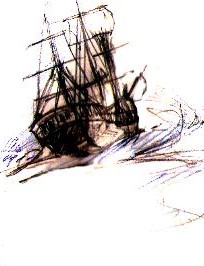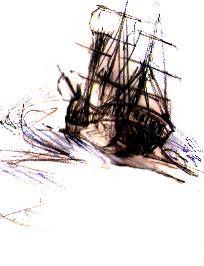

She was Lady Mary Wolveston before she married Killigrew. She was sentenced to death for piracy, reprieved only because of the Queen's favour and the fact hat her husband John Killigrew was in the powerful position of being on the Commission investigating Piracy The Tregony Pomeroy?s also served on these commissions into piracy and may well have served on the same commissions.
The Killigrew family were secret backers of piracy in Cornwall.
Lady Killigrew took up this endeavour with great enthusiasm and went on many piratical excursions along the English coast.
She herself took up hersword and helped the pillage, the crew were killed and the cargo stolen. This lady pirate's crew rowed away with loot that included jewels, heavy silver and pieces of eight.
Queen Elizabeth I heard about the attack and was very angry. Lady Killigrew was arrested, tried, found guilty of piracy and sentenced to be hanged along with her lieutenants. At the last minute the Queen, who liked Lady Killigrew relented and she was reprieved and given a long jail sentence.
Her son Sir John died in prison as well, in the Fleet Prison for debtors
Sir John Killigrew was such a person. The Killigrew?s family were well known in the early 17th century as smugglers and privateers. As landowner for Lizard Point, he enlisted the help ;of his cousin Lord Dorchester (Ambassador to Holland), in obtaining a Patent for a lighthouse. In May 1619, James I authorised the Duke of Buckingham, a close friend of the King, to issue a Patent to Sir John Killigrew. The Duke of Buckingham signed this document in his capacity as ;Lord High Admiral of England. Killigrew was surprised to note that his Lizard Point Patent only gave him the right to collect a lighthouse levy from shipping on a voluntary basis.
During the building of the Lizard lighthouse in the summer of 1619, local inhabitants attacked the workforce and pulled down the partly completed tower. Killigrew was forced to employ a company of dragoons to protect his builders. The local community openly condemned the ;proposed lighthouse, as they believed it would take away their livelihood from the rich pickings of winter shipwrecks.
In 1620 the Lizard light was first lit but the voluntary contribution for its upkeep failed to materialise. On several occasions Sir John Killigrew sent a group of his heartless smugglers out in ;his cutter to intercept passing ships. Near the end of 1620 the Lizard light was extinguished. Two nights after Killigrew made this decision a fleet of ships coming up the English Channel nearly ran aground off the Lizard Point.
Although the ship Masters paid the lighthouse levy, the matter reached the ears of King James. By the middle of 1621 the number of ships wrecked near the Lizard Point had become totally unacceptable. The following year, James I ordered the light to be relit. In 1623 the King ordered that 'a lighthouse should remain for all times on that part of the coast' and extended the Patent for 'as long as Sir John Killigrew or his partner Thynne may live'.
It is difficult to understand Sir John Killigrew's motive for erecting the lighthouse on the Lizard Point. On one hand he appeared to be the protector of ships whilst on the other a smuggler ;privateer and wrecker. When the Lizard light was unlit in 1627, for which no explanation can be found, Sir John Killigrew was accused of piracy after a ;silver bullion ship was wrecked near the Point.
Report was made to the Lords of the Privy Council and to Lord Dorchester, that Sir John Killigrew had ordered his men tosalvage the cargo and threatened to kill the ship's surviving crew. The Privy Council accepted Sir John Killigrew's explanation that he had acted under 'Custom and Descent' and that the King had received his share of the cargo in ;the normal way. Sir John Killigrew died two years after his partner Thynne in 1630. Although a relative applied fo the Patent, it was refused.